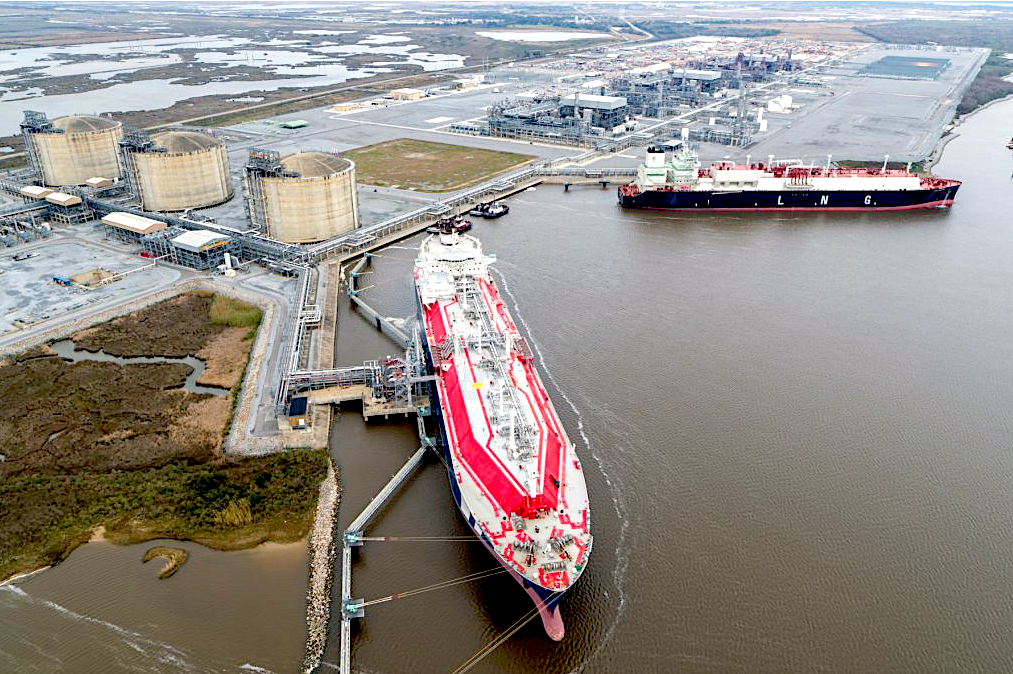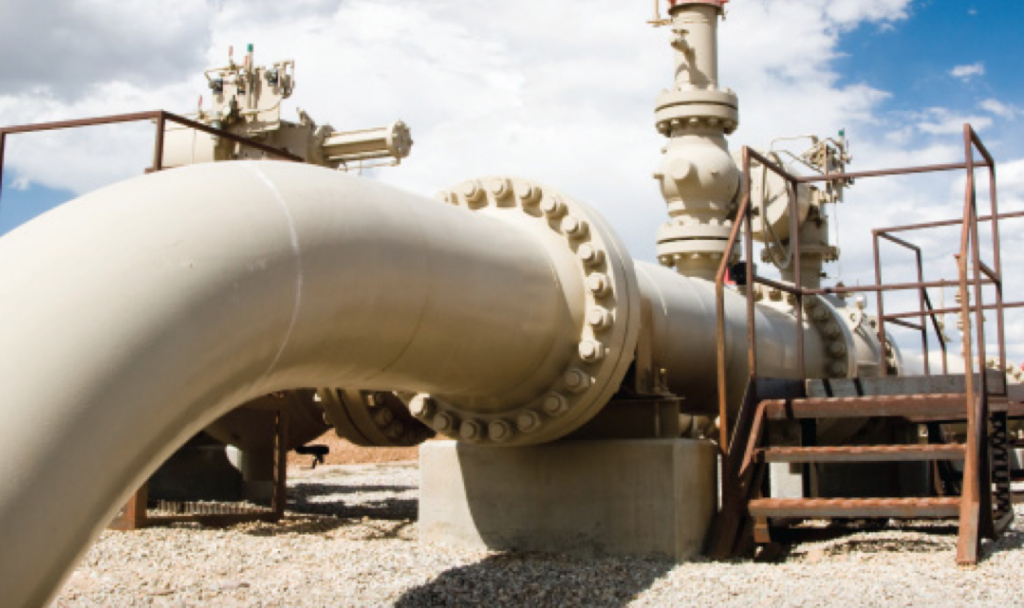Shock Doctrine: Industry Exploiting Ukraine War for Liquefied Natural Gas Expansion
ENERGY, 8 May 2023
Olivia Rosane | Consortium News - TRANSCEND Media Service
In an investigation targeting the “shock doctrine” practices of the gas industry, Greenpeace is calling on policymakers in both the U.S. and EU to move away from expanding LNG infrastructure before it’s too late.
28 Apr 2023 – In what it calls “one of the most blatant examples of the ‘shock doctrine,’” a Greenpeace report released this week reveals how the gas industry took advantage of Russia’s invasion of Ukraine to lock Europe and the U.S. into building new liquefied natural gas (LNG) infrastructure that threatens the well-being of both frontline communities and the entire planet.
Projects approved in the U.S. alone could, by 2030, push its exports past what the International Energy Agency has budgeted for the entire global LNG trade if world leaders want to reach net zero greenhouse gas emissions by 2050 and stop global warming at 1.5°C above pre-industrial levels, the report said.
“Our investigation exposes the truth behind the corporate and political push for more fossil gas imports from the U.S. to European countries: The bottom line is that fossil gas only profits the industry, it is dirty, toxic, not needed, and not wanted,” said Anusha Narayanan, climate campaign director with Greenpeace USA.
🚨BREAKING🚨
New @Greenpeace International report reveals the gas industry is pushing the US & Europe into contracts that would 🔥roast🔥 the planet 🧵
This includes a 1767% increase in liquefied gas (LNG) exports from the US ➡️ Europe since 2018!
Read: https://t.co/cmicS2m5Xi
— Greenpeace USA (@greenpeaceusa) April 27, 2023
Russia’s invasion of Ukraine in February of 2022 sent the EU into an energy crisis as it scrambled to prepare for the following winter without relying on Russian gas — which supplied almost 40 percent of the bloc’s gas in 2021. The U.S. rushed to fill in the gap, with the EU’s imports skyrocketing by 140 percent in 2022, making the bloc the world’s top importer of U.S. gas.

However, the solution pushed by the gas industry in both countries was not a stop-gap measure to keep homes warm in the short-term while building up renewable energy capacity to insure against similar crises in the future, as Greenpeace details in the report titled Who Profits From War – How Gas Corporations Capitalise from War in Ukraine.
Instead, the EU’s REPowerEU plan invested $20.9 billion in gas infrastructure. The bloc has already started building eight liquefied gas terminals and has proposed 38 more. In the U.S., new gas infrastructure approved so far would double export capacity to 439 billion cubic meters per year.
Many of the gas contracts last 10 to 15 years, and most of the projects won’t even begin working until 2026, too late to satisfy the initial need but in plenty of time to spew greenhouse gasses into the air during a critical decade for climate action.

European Commission President Ursula von der Leyen on March 24, 2022, during a session that MPs used to condemn Russia’s attack on Ukraine, urge further sanctions on Moscow and “protect the European economy.” (European Parliament, Flickr, CC-BY-4.0)
According to Greenpeace’s estimate, the new European infrastructure would emit 950 million tonnes of CO2-eq per year while U.S. export terminals — including those in operation, under construction, and approved for construction — would emit 1,824 million tonnes of CO2-eq per year. Taken together, that’s the yearly equivalent of adding 604 million new cars to the roads.
“The gas industry is using today’s news — the war and the energy crisis–to try to lock in more gas for decades, even though the industry knows it’ll be disastrous for the climate and international stability,” senior research fellow at the Oxford Sustainable Law Programme Ben Franta said in a DeSmog report cited by Greenpeace.
That report detailed how the gas industry changed its messaging following Russia’s invasion from emphasizing the “energy transition” to “energy security.”

(Wikideas1, CC0, Wikimedia Commons)
In the 10 months before Feb. 24, 2022, four major industry groups only tweeted about energy security 3 percent of the time. Afterwards, the number of tweets on the theme skyrocketed by more than 10 times. In the lead up to RePowerEU, one of these groups — Gas Infrastructure Europe (GIE) — lobbied policy makers for more LNG projects and argued that their focus should be less on 2050 climate targets and more on the immediate crisis.
“The extreme energy prices of last year, and the current threats to security of supply require a focus on the shorter term,” the group said.
Yet critics warn such a shorter-term focus would have disastrous consequences for everyone except fossil fuel companies, who have already made record profits off the energy crisis.
U.N. Secretary-General António Guterres has called on both the U.S. and the E.U. to bump up their carbon neutrality deadlines to 2040, and, to limit warming to 1.5°C, the E.U. needs to stop burning gas by 2035.
The new infrastructure is not required to meet current needs, Greenpeace said. The U.S. already has enough in place to increase short-term exports to Europe, and, despite last year’s crisis, according to the IEA, natural gas demand in the bloc actually fell its farthest ever in 2022 by 55 billion cubic meters.

The Cameron LNG liquefaction export facility in Hackberry, Louisiana. (Cameron LNG)
Yet, beyond interfering with its decarbonization timeline, the E.U.’s pivot from Russian gas via pipeline to imported LNG also threatens its climate goals because LNG is more carbon intensive and often comes from fracked U.S. gas that Greenpeace calls one of “the most polluting and dirty forms of energy in the world.”
The use of fracked gas also exacts an environmental justice cost. Most of the new U.S. export infrastructure is being funded by EU banks, despite the fact that many of these banks have a ban on financing fracking and many EU countries have also banned the practice within their borders because of health and environmental concerns.
Living near oil and gas activity — including fracking —has been linked to cancer, respiratory disease, low birth rates and other health impacts. All but one of the U.S. LNG terminals either in operation or under construction is located in an area considered “disadvantaged” by the Sierra Club.

July 2014: The Lost Hills Trailer Park in the San Joaquin Valley of California near fracking activity in the nearby Lost Hills Oil Field. (Sarah Craig/Faces of Fracking, Flickr, CC BY-NC-ND 2.0)
Community advocate John Beard of Texas, lives near three such terminals: the “Sabine Pass LNG” — the nation’s largest terminal —the under-construction “Golden Pass LNG,” and the Port Arthur LNG project.
“There is no such thing as ‘freedom’ gas,” he told Greenpeace. “It comes with a cost. That cost is the lives and health of people in the Gulf South and deadly climate consequences worldwide.”
Greenpeace is calling on policymakers in both the U.S. and E.U. to move away from expanding LNG infrastructure before it’s too late.
Among other things, the advocacy group recommended that the EU stop using fossil gas by 2035 and phase out LNG even earlier; cancel all plans to build new terminals and expand current ones; and both stop long-term export contracts and prevent existing ones from being extended.
In the U.S., the Biden administration should stop approving new projects that would worsen the climate crisis, stop approving LNG exports, and put its political weight behind ending international funding for LNG and other fossil fuels at the upcoming G7, G20, and COP28 conferences.
“Citizens voted for transformative climate action,” Narayanan said. “Governments must lead in the climate fight, not be puppeteered by gas operators who sacrifice the health and safety of communities simply to boost their profits.”
______________________________________________
Olivia Rosane is a staff writer for Common Dreams.
Go to Original – consortiumnews.com
Tags: Corruption, Denmark, Eastern Europe, Energy, European Union, Gas, Hegemony, Imperialism, Military Industrial Media Complex, Multipolar World Order, NATO, Nordstream 2, Norway, Nuclear war, Pentagon, Proxy War, Putin, Russia, Seymour Hersh, State Terrorism, US Military, US empire, USA, Ukraine, War Economy, Warfare, West
DISCLAIMER: The statements, views and opinions expressed in pieces republished here are solely those of the authors and do not necessarily represent those of TMS. In accordance with title 17 U.S.C. section 107, this material is distributed without profit to those who have expressed a prior interest in receiving the included information for research and educational purposes. TMS has no affiliation whatsoever with the originator of this article nor is TMS endorsed or sponsored by the originator. “GO TO ORIGINAL” links are provided as a convenience to our readers and allow for verification of authenticity. However, as originating pages are often updated by their originating host sites, the versions posted may not match the versions our readers view when clicking the “GO TO ORIGINAL” links. This site contains copyrighted material the use of which has not always been specifically authorized by the copyright owner. We are making such material available in our efforts to advance understanding of environmental, political, human rights, economic, democracy, scientific, and social justice issues, etc. We believe this constitutes a ‘fair use’ of any such copyrighted material as provided for in section 107 of the US Copyright Law. In accordance with Title 17 U.S.C. Section 107, the material on this site is distributed without profit to those who have expressed a prior interest in receiving the included information for research and educational purposes. For more information go to: http://www.law.cornell.edu/uscode/17/107.shtml. If you wish to use copyrighted material from this site for purposes of your own that go beyond ‘fair use’, you must obtain permission from the copyright owner.
